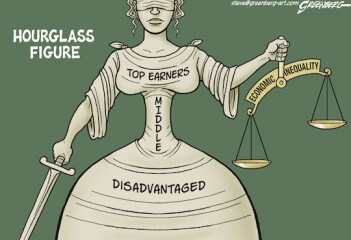 Fred Allebach is a member of the City of Sonoma’s Community Services and Environmental Commission, and an Advisory Committee member of the Sonoma Valley Groundwater Sustainability Agency. Fred is a member of Sonoma Overlook Trail Stewards, as well as Sonoma Valley Housing Group and Transition Sonoma Valley.
Fred Allebach is a member of the City of Sonoma’s Community Services and Environmental Commission, and an Advisory Committee member of the Sonoma Valley Groundwater Sustainability Agency. Fred is a member of Sonoma Overlook Trail Stewards, as well as Sonoma Valley Housing Group and Transition Sonoma Valley.
Death by gentrification

We hear a lot of talk about and reference to the area median income (AMI), median home price, and median rent. What’s the median? It’s the middle, “denoting or relating to a value or quantity lying at the midpoint of a frequency distribution of observed values or quantities, such that there is an equal probability of falling above or below it.”
Today’s U.S. economy is called the hourglass economy because the middle is nearly gone. During the post-WWII halcyon days in the U.S., there was much less difference between the wealthiest and those in the middle. Median income in those days allowed for blue collar, working-class people to buy a house. Today, the median income has fallen into the bottom of the hourglass.
In post-fire Sonoma County, nearly half of residents are renters; no one who makes median income can afford median home prices and median rents, let alone inflated health care and food costs. This is an impossible situation, one that creates poverty, displaces the lower AMI cohort, and produces more and more homelessness.
How is it that the median costs got so far out of whack with median earnings? One critical cause is demographic. It’s called gentrification. Wealthy South Bay people see Sonoma Valley as a good housing investment. Costs are even greater in the San Jose area; people there cash out, buy and remodel a place up here, and still have money left. The more of them that come in, the more real estate prices get run up. The median income gets statistically skewed higher, and so do median prices all around.
This has a negative consequence for those who make 60% AMI or less, which is the case for many areas in the urban, unincorporated area next to Sonoma which are classed as disadvantaged communities. Why a negative consequence? Because people at the lower end find themselves further and further away from being able to afford anything.
Temelec, a Census place, has a median income of $40,000. The Census tract along the Highway 12 corridor from Verano Ave. to Agua Caliente, has a median income of $50,000. And five Springs-area Census Block groups have median incomes ranging from $38,000, $41,000, $43,000, $45,000 and $50,000 – this from 2016 Census-collected data. These people, mostly renters, are going to have to spend half or more of their income just to pay median rent.
As the median income point rises, because of an influx of wealthier people (gentrification), the lower AMI income stays the same. This is documented in the North Bay Jobs with Justice’s State of Working Sonoma Fall 2018 study.
The higher the median gets skewed, the more the people at the bottom suffer. Hardly any housing projects serve the very lowest income categories. Market rate housing only serves the top 10%. Housing projects of any size have to have an inclusionary requirement so that 20% of the units are “affordable,” but these units are almost always for people who make 100% to 120% of AMI.
The upshot is that our business-as-usual economic system is creating poverty, suffering, and hardship; doesn’t produce enough Affordable Housing for workers; and then spits out homeless people as the final product. Then we try and push the homeless as far out of sight as possible.
When you hear someone say, “we need housing,” you need to ask one question. Is it market rate or deed-restricted? Market rate is for the top 10%. Inclusionary ordinances, while well intentioned, don’t address and mitigate hourglass economy affordability in an adequate or proportional way.
Since the business-as-usual economy is only making things worse, the clear answer to our shocking local inequity issues is two-fold: one, more renter protections, and two, more tax credit-subsidized housing built by non-profit developers.




One thought on “Death by gentrification”
Comments are closed.